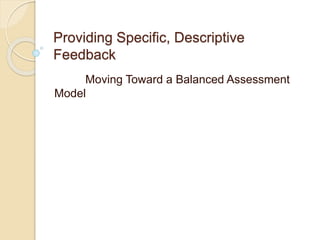
Providing specific, descriptive feedback
- 1. Providing Specific, Descriptive Feedback Moving Toward a Balanced Assessment Model
- 2. Guiding Questions How does descriptive feedback improve student achievement? How can I give more timely, specific feedback to my students? What current practices and resources exist that can assist the teacher?
- 3. The Effect of Feedback Consider the following statement, reflecting on the extent to which you agree with the statement and considering the reasoning behind your decision. “The most powerful single modification that enhances achievement is feedback. The simplest prescription for improving education must be ‘dollops of feedback’ (p.9).” As quoted in Marzano, R. J., Pickering, D. J., & Pollock, J. E. (2001). Classroom instruction that works: Research-based strategies for increasing student achievement. Alexandria, VA: Association for Supervision and Curriculum Development.
- 4. What the Research Says… To enhance achievement, feedback should be 1. corrective in nature. ◦ Effective feedback should beyond correct vs. incorrect. It should offer students an explanation of what they are or are not doing correct. 2. timely. ◦ The greater the delay in providing feedback often results in the greater the negative effect on achievement. 3. specific to a criterion. ◦ Criterion-referenced feedback describes where students are relative to a specific skill or set of knowledge. However, norm-referenced feedback describes where students are in relation to other students. This type of feedback does not offer students understanding about their learning. As quoted in Marzano, R. J., Pickering, D. J., & Pollock, J. E. (2001). Classroom instruction that works: Research-based strategies for increasing student achievement. Alexandria, VA: Association for Supervision and Curriculum Development.
- 5. Implications for the Classroom “…this means that providing students with feedback in terms of specific levels of knowledge or skills is better than simply providing students with a percentage score.” As quoted in Marzano, R. J., Pickering, D. J., & Pollock, J. E. (2001). Classroom instruction that works: Research-based strategies for increasing student achievement. Alexandria, VA: Association for Supervision and Curriculum Development. Rubrics, or scoring guides, are recommended as a tool to facilitate
- 6. Feedback that Fits How does what you have read “mesh” with your current practice, inspire future practice, and raise questions for further study? http://www.ascd.org/publications/education al- leadership/dec07/vol65/num04/Feedback- That-
- 7. Application of Ideas Working with a partner or in a small group of three to four participants, select one piece of student work to examine and generate feedback. Consider the following ideas as the group DESCRIBES the student work. Monitor the discussion for the tendency to EVALUATE the work. What Student is Working On Elements that seems apparent Tasks student is trying to accomplish How the student is visible in the work What does the student appear to value What does s/he know how to do re: skills What does the student seem on the verge of understanding “I wonder”
- 8. Feedback Discussion Consider the Implications for Feedback What are the strengths of the work? What are the weak areas within the work? What misconceptions does the student hold? Based on the analysis, consider the following questions. What feedback should be offered to the student? How will the rubric or scoring guide help the student respond to the feedback? To what extent have we planned for how to model the expectations so that students may react positively to the feedback? How must we adjust our language to ensure that the feedback is constructive and not overtly critical? How does examining student work with colleagues help in providing specific, descriptive feedback?
- 9. Individual Reflection 1. What assessment tools and resources do you currently use that guide (would guide) feedback for students? 2. How do you (will you) provide an opportunity for students to respond to or revise their work based on the feedback? 3. How do you imagine feedback changing your instruction and student learning? 4. Based on the readings and activities, what goals will you set with regard to giving feedback to students?
- 10. Next Steps: I am interested in … the quality of comments and the language choices I make when offering feedback. Accountable Talk (link to article) Johnston, P. H. (2004). Choice words: How our language affects children's learning. Portland, ME: Stenhouse. Brookhart, S. M. (2008). How to give effective feedback to your students. Alexandria, VA: ASCD.
- 11. Next Steps: I am interested in … how to develop rubrics that can lead to more effective feedback. Link to Rubric Module the relationship between assessment tasks and feedback http://www.newhorizons.org/strategies/assess/ wiggins.htm (Assessment as Feedback) how I can move my students from feedback to self-assessment and goal setting. Link to Self-Assessment Module